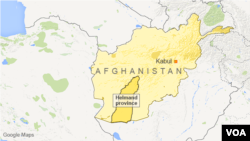Officials in Afghanistan confirmed Saturday that Islamic State militants have forcibly shut down telecommunications services in two districts of the eastern Kunar province.
Provincial Director of Communications Sayed Ahmad Madad told VOA that Manogi and Chapidari districts have been without cell phone service for two weeks.
IS militants, he said, have threatened to destroy communication towers if Afghan companies running the operation in the area attempted to resume service.
Islamic State operates in Afghanistan under its local name of Khorasan, commonly referred to as IS-K.
Provincial authorities say the terrorist group is active in five districts of the province. The group launched its regional operations in early 2015 from bases in the eastern province of Nangarhar, which borders Kunar.
Both the volatile Afghan provinces border Pakistan. IS militants lately, are also expanding and intensifying attacks in northern Jowzhan province. U.S. military airstrikes this month in the area have killed dozens of IS members, including the terrorist group's chief of operations for northern Afghanistan, Qari Hekmatullah.
Meanwhile, officials and residents said the Taliban has not lifted its ban on cell phone service in insurgent-controlled areas of southern Helmand province.
The Islamist insurgency controls or contests much of the country's largest poppy producing province.
The Taliban "believe the Afghan government is utilizing private communication systems for military and intelligence operations," Omidullah Zaheer, communications director of Helmand, told VOA.
Insurgents sent a note to all private communication companies in the area within the last week, asking them to suspend their operations, he added.
The insurgent action has shut down at least 120 communications towers in the area at a time when Afghan security forces backed by U.S. counterparts have stepped up counterinsurgency operations in Helmand.
The Afghan defense minister's spokesman, Mohammad Radmanesh, however, told VOA the disruption would not affect their ongoing security operations because the military has its own "tactical communication system" independent of private services. But the action has added to the problems of residents in the area, he added.
The Taliban has also pressured communication companies in parts of nearby Uruzgan and Zabul provinces where insurgents frequently stage raids on Afghan forces.
The insurgent group's move against cell phone service comes as the Taliban is expected to announce its so-called annual spring offensive later this month, which leads to more hostilities across Afghanistan.
Radmanesh did not rule out opium harvest season as a possible motive behind the Taliban's move against communication services. He said the insurgents want to prevent locals from tipping off security forces about the presence of the Taliban in poppy fields.
The insurgent group, according to U.S. military estimates, receives close to 60 percent of its revenue from narcotics activities, including smuggling and taxing local growers.
A new air campaign against Taliban financial streams began in November 2017 under U.S. President Donald Trump's new Afghan war strategy, which has destroyed hundreds of the Taliban's drug-processing labs in different parts of the country, mainly in Helmand.
"Airstrikes in March cost the Taliban more than $40 million in lost revenue," the U.S. military announced on Friday. It said that 339 precision weapons have been used against Taliban and the Islamic State, "degrading, dismantling and disrupting their revenue sources."
According to a report by the U.N. Office on Drug and Crime, the total area under opium poppy cultivation in Afghanistan, the world's largest opium-poppy producer, was estimated at 328,000 hectares in 2017, a 63 percent increase compared with 2016.
"In Helmand province alone, cultivation increased by 63,700 hectares (+79%), which accounted for about half of the total national increase," the U.N. report said.







